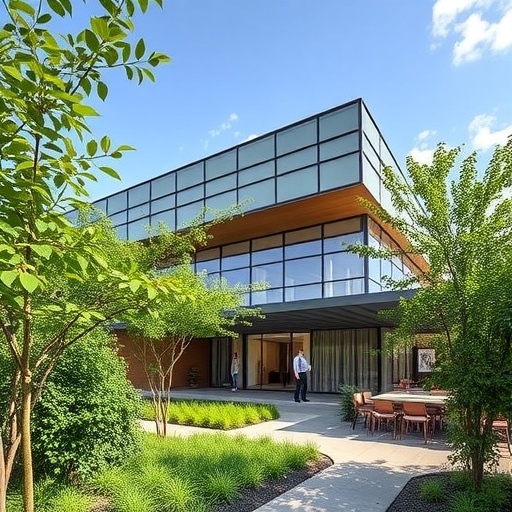
The COVID-19 pandemic has precipitated a profound reexamination of how we conceive, design, and inhabit the built environment, with sustainability assuming an undeniably central role. As nations grappled with the unprecedented challenges posed by the viral outbreak, the interaction between human health, urban infrastructure, and environmental resilience emerged as a critical nexus for research and policy innovation. In this context, the recent study by Parzniewski, Breen, Ru, and colleagues titled Evolving Interconnections: Themes and Trends in Sustainable Built Environment Responses to the COVID-19 Pandemic presents a comprehensive analysis of how sustainable design principles have evolved and adapted in response to the pandemic’s multifaceted impacts. This article elucidates the core themes, technological advancements, and policy shifts shaping the current and future trajectory of sustainable built environments worldwide.
At its core, the pandemic amplified the urgency of integrating health security imperatives into sustainable urban planning frameworks. Social distancing mandates and lockdowns exposed glaring vulnerabilities in densely populated urban centers and mass transit systems, highlighting the need for spatial reconfiguration to mitigate contagion risks. The study underscores how architects and planners have begun to embrace adaptive building layouts, flexible public spaces, and multi-functional infrastructures that can dynamically respond to varying levels of public health threat without compromising sustainability objectives. This represents a paradigm shift from static design approaches toward fluid and resilient urban forms.
Moreover, the research identifies a surge in digital and sensor technologies being embedded within building systems as vital tools for real-time monitoring of environmental parameters and occupant health. The integration of Internet of Things (IoT) devices, coupled with advanced data analytics, enables precise control over ventilation, air quality, and crowd density within indoor environments. These technological adaptations not only enhance infection control but also promote energy efficiency by optimizing resource usage based on dynamic occupancy patterns. This confluence of health-conscious design and digital innovation is emerging as a hallmark of next-generation sustainable buildings.
Ventilation emerges as a particularly critical factor scrutinized throughout the study. Traditional HVAC systems, often optimized for thermal comfort and energy savings, required rapid recalibration to prioritize pathogen dilution and air exchange rates effective against airborne virus transmission. Adaptive ventilation strategies, including increased filtration efficiency, ultraviolet germicidal irradiation, and natural ventilation enhancements such as operable windows and atrium designs, are detailed as scalable solutions widely adopted during the pandemic. These interventions represent a fusion of engineering controls with architectural ingenuity aimed at sustaining indoor environmental quality without incurring prohibitive energy costs.
The environmental repercussions of the pandemic also shaped discourse around material selection and construction processes. With heightened awareness of infection vectors on surfaces, the study explores how antimicrobial materials and touchless technologies—ranging from door handles to elevator buttons—have been incorporated to enhance hygiene while sustaining eco-friendly manufacturing standards. Additionally, reduced construction activity during lockdown periods accelerated interest in modular and prefabricated building techniques, which confer advantages in quality control, waste reduction, and accelerated timelines without sacrificing sustainability credentials.
Urban public spaces, long championed as vital social commons, faced unprecedented restrictions during the pandemic. Parzniewski et al. emphasize innovative reimaginings of these spaces to accommodate physical distancing while enhancing community well-being. Tactical urbanism approaches involved temporary street closures to vehicular traffic, expanded pedestrian zones, and incorporation of green infrastructure features such as bioswales and urban gardens that provide both ecological benefits and mental health respite. These interventions highlight an emerging trend toward human-centered and nature-integrated urban design strategies resilient to health crises.
Transportation infrastructures underwent similarly transformative adaptations. The decline in public transit ridership stirred concerns over increased carbon emissions from private vehicle use. The study delves into how cities have promoted micromobility solutions—such as bike lanes and e-scooter networks—leveraging sustainable transport to reduce reliance on fossil fuels and enhance social distancing potential. The integration of these modes into wider mobility ecosystems underscores a systemic approach that reconciles pandemic exigencies with decarbonization goals.
Energy consumption patterns within buildings experienced notable fluctuations, prompting reassessment of grid interactions and renewable integration. The research discusses how work-from-home shifts influenced electrical load profiles, driving innovation in smart energy management systems and demand response protocols. Importantly, buildings equipped with distributed energy resources, including rooftop solar and energy storage, demonstrated enhanced operational resilience, offering lessons for future-proofing energy infrastructure in the face of pandemics and climate variability.
In the realm of policy, the paper highlights how governments and institutions expedited regulatory flexibility to facilitate rapid deployment of adaptive measures without compromising environmental standards. Emergency ordinances that allowed for temporary repurposing of spaces—such as converting conference centers into health facilities—illustrate the balance between agility and sustainability. The authors also document increased emphasis on cross-sector collaboration, with public health, urban planning, and environmental agencies coordinating to establish integrated guidelines that address complex pandemic challenges holistically.
An especially innovative dimension explored is the incorporation of biophilic design principles, which prioritize human-nature connections to promote psychological and physiological health. With lockdowns and social restrictions intensifying mental health burdens, green walls, indoor planting schemes, and access to daylight emerged as critical features enhancing user well-being in sustainable built environments. These elements, rooted in both ecological and health sciences, suggest a multidisciplinary approach to design that transcends traditional silos.
The pandemic also catalyzed reconsideration of building occupancy models, challenging assumptions about density and shared space use. Flexible zoning and room usage strategies—enabled by digital occupancy tracking and adaptable furnishings—allow spaces to morph according to realtime needs, mitigating contagion risk while maximizing utility. This dynamically configurable approach represents a fundamental departure from rigid architectural typologies, signaling a future where buildings are conceived as living systems responsive to external stressors.
Waste management within built environments is another sphere impacted by the pandemic, with increased single-use protective equipment generating new challenges for sustainability. The authors discuss innovations in waste segregation, on-site treatment, and circular economy principles being increasingly integrated into building operations to reduce environmental footprints. Emphasis on stakeholder education and behavior change complements technological solutions, reflecting a comprehensive sustainability strategy addressing pandemic-induced waste streams.
Digital twin technologies and virtual modeling have gained prominence as powerful tools to simulate and optimize pandemic response interventions within buildings and urban contexts. By creating real-time, data-driven virtual replicas of physical spaces, planners and managers can test ventilation scenarios, crowd flows, and emergency protocols without disruption. This predictive capacity enhances decision-making precision, reduces risk, and aligns with sustainability’s ethos of resource-efficient problem-solving.
The paper further documents how pandemic experiences have shifted global discourse toward equity and inclusivity in sustainable built environment strategies. Marginalized and underserved communities often bore disproportionate health and economic impacts, prompting calls for universally accessible design interventions that bridge social inequities. Equitable access to green spaces, healthy housing, and resilient infrastructure emerges as a foundational pillar in redefining sustainability post-pandemic.
Looking ahead, the authors posit that COVID-19 has accelerated the integration of health resilience as an inseparable component of sustainable built environments rather than an ancillary consideration. This holistic framing aligns with emerging global frameworks such as the United Nations’ Sustainable Development Goals and the Sendai Framework for Disaster Risk Reduction, signaling a convergence of public health, environmental sustainability, and urban resilience agendas.
In summary, the work of Parzniewski, Breen, Ru, and their colleagues offers a critical synthesis of evolving themes and tangible trends that underscore the dynamic interrelations between pandemic challenges and sustainable built environment responses. By bridging technical innovation, policy evolution, and human-centered design, this research provides an essential roadmap to cultivating resilient, healthy, and environmentally sound urban environments capable of withstanding future crises.
Subject of Research: Evolution and trends in sustainable built environment adaptations in response to the COVID-19 pandemic.
Article Title: Evolving Interconnections: Themes and Trends in Sustainable Built Environment Responses to the COVID-19 Pandemic
Article References:
Parzniewski, S., Breen, K., Ru, S. et al. Evolving Interconnections: Themes and Trends in Sustainable Built Environment Responses to the COVID-19 Pandemic.
Int J Disaster Risk Sci (2025). https://doi.org/10.1007/s13753-025-00634-5
Image Credits: AI Generated
Tags: adaptive building layoutsCOVID-19 impact on urban designenvironmental resilience in architectureflexible public spacesfuture of sustainable built environmentshealth security in urban planningmulti-functional infrastructurespandemic response in infrastructurepolicy shifts in sustainable developmentsustainable building trendstechnological advancements in sustainable designurban infrastructure vulnerabilities



